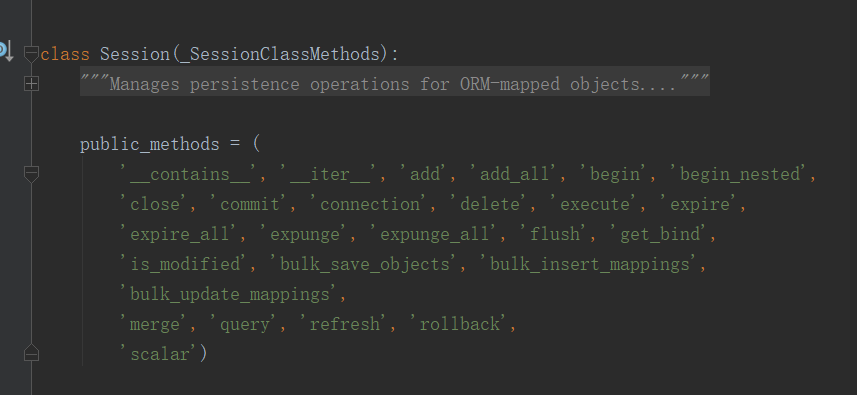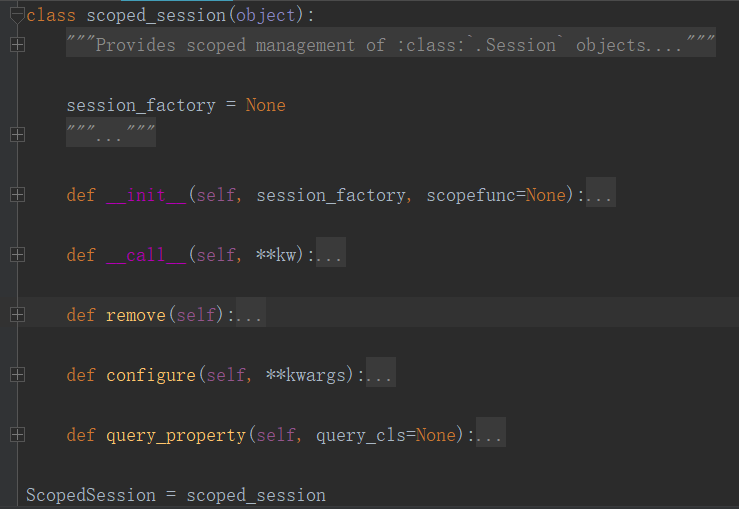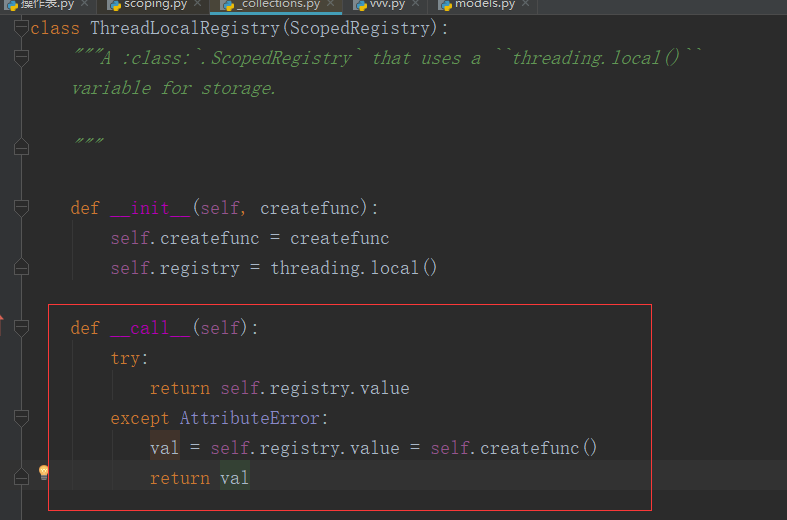SALALchemy Session与scoped_session的源码分析
我们发现Session与scoped_session都有一些方法:
但是scoped_session的源码里面没有设置这些方法让我们从源码里去窥探下源码在哪里设置了这些方法:
Session里面的方法放在了public_methods里面:

scoped_session的源码里面没有这些方法?:

那它怎么实现这些方法的呢?
我们看到了它的构造方法:
def __init__(self, session_factory, scopefunc=None):
"""Construct a new :class:`.scoped_session`. :param session_factory: a factory to create new :class:`.Session`
instances. This is usually, but not necessarily, an instance
of :class:`.sessionmaker`.
:param scopefunc: optional function which defines
the current scope. If not passed, the :class:`.scoped_session`
object assumes "thread-local" scope, and will use
a Python ``threading.local()`` in order to maintain the current
:class:`.Session`. If passed, the function should return
a hashable token; this token will be used as the key in a
dictionary in order to store and retrieve the current
:class:`.Session`. """
self.session_factory = session_factory if scopefunc:
self.registry = ScopedRegistry(session_factory, scopefunc)
else:
self.registry = ThreadLocalRegistry(session_factory)
第一次进来时,scopefunc是空的。
走else,
self.registry = ThreadLocalRegistry(session_factory)
就会实例化:ThreadLocalRegistry。
class ThreadLocalRegistry(ScopedRegistry):
"""A :class:`.ScopedRegistry` that uses a ``threading.local()``
variable for storage. """ def __init__(self, createfunc):
self.createfunc = createfunc
self.registry = threading.local()
里面有两个对象 self.createfunc和registry:
registry是唯一标识,
session加上括号就会执行__call__方法:

因为self.registry.value第一次进入没有值:
所以走except 就是执行self.createfunc()往前找传的值是session_factory那么session_factory是谁呢?就是我们传入的session,也就是实例化了我们的session。
就这就会走下面的方法:
def instrument(name):
def do(self, *args, **kwargs):
return getattr(self.registry(), name)(*args, **kwargs)
return do for meth in Session.public_methods:
setattr(scoped_session, meth, instrument(meth))
方法二:
我们发现
class scoped_session(object):
"""Provides scoped management of :class:`.Session` objects. See :ref:`unitofwork_contextual` for a tutorial. """ session_factory = None
"""The `session_factory` provided to `__init__` is stored in this
attribute and may be accessed at a later time. This can be useful when
a new non-scoped :class:`.Session` or :class:`.Connection` to the
database is needed.""" def __init__(self, session_factory, scopefunc=None):
"""Construct a new :class:`.scoped_session`. :param session_factory: a factory to create new :class:`.Session`
instances. This is usually, but not necessarily, an instance
of :class:`.sessionmaker`.
:param scopefunc: optional function which defines
the current scope. If not passed, the :class:`.scoped_session`
object assumes "thread-local" scope, and will use
a Python ``threading.local()`` in order to maintain the current
:class:`.Session`. If passed, the function should return
a hashable token; this token will be used as the key in a
dictionary in order to store and retrieve the current
:class:`.Session`. """
self.session_factory = session_factory if scopefunc:
self.registry = ScopedRegistry(session_factory, scopefunc)
else:
self.registry = ThreadLocalRegistry(session_factory)
如果我们给
scopefunc传值就会走if语句,
class ScopedRegistry(object):
"""A Registry that can store one or multiple instances of a single
class on the basis of a "scope" function. The object implements ``__call__`` as the "getter", so by
calling ``myregistry()`` the contained object is returned
for the current scope. :param createfunc:
a callable that returns a new object to be placed in the registry :param scopefunc:
a callable that will return a key to store/retrieve an object.
""" def __init__(self, createfunc, scopefunc):
"""Construct a new :class:`.ScopedRegistry`. :param createfunc: A creation function that will generate
a new value for the current scope, if none is present. :param scopefunc: A function that returns a hashable
token representing the current scope (such as, current
thread identifier). """
self.createfunc = createfunc
self.scopefunc = scopefunc
self.registry = {} def __call__(self):
key = self.scopefunc()
try:
return self.registry[key]
except KeyError:
return self.registry.setdefault(key, self.createfunc())
我们看到如果对象加括号就会走__call__方法:
第一次没有值,就会走except,设置并且实例化session。
往下方法和方式一一样啦。
在执行到最后我们要加上一句:
session.remove()
我们来看下这句话做了什么?
def remove(self):
"""Dispose of the current :class:`.Session`, if present. This will first call :meth:`.Session.close` method
on the current :class:`.Session`, which releases any existing
transactional/connection resources still being held; transactions
specifically are rolled back. The :class:`.Session` is then
discarded. Upon next usage within the same scope,
the :class:`.scoped_session` will produce a new
:class:`.Session` object. """ if self.registry.has():
self.registry().close()
self.registry.clear()
我们进入has看下:
def has(self):
return hasattr(self.registry, "value")
如果有值就执行close方法。
然后在执行clear方法:
def clear(self):
try:
del self.registry.value
except AttributeError:
pass
SALALchemy Session与scoped_session的源码分析的更多相关文章
- SqlAlchemy 中操作数据库时session和scoped_session的区别(源码分析)
原生session: from sqlalchemy.orm import sessionmaker from sqlalchemy import create_engine from sqlalch ...
- springMVC源码分析--国际化实现Session和Cookie(二)
上一篇博客springMVC源码分析--国际化LocaleResolver(一)中我们介绍了springMVC提供的国际化的解决方案,接下来我们根据springMVC提供的解决方案来简单的实现一个多语 ...
- [asp.net core 源码分析] 01 - Session
1.Session文档介绍 毋庸置疑学习.Net core最好的方法之一就是学习微软.Net core的官方文档:https://docs.microsoft.com/zh-cn/aspnet/cor ...
- TOMCAT8源码分析——SESSION管理分析(上)
前言 对于广大java开发者而已,对于J2EE规范中的Session应该并不陌生,我们可以使用Session管理用户的会话信息,最常见的就是拿Session用来存放用户登录.身份.权限及状态等信息.对 ...
- Tomcat源码分析——Session管理分析(下)
前言 在<TOMCAT源码分析——SESSION管理分析(上)>一文中我介绍了Session.Session管理器,还以StandardManager为例介绍了Session管理器的初始化 ...
- Tomcat源码分析——Session管理分析(上)
前言 对于广大java开发者而已,对于J2EE规范中的Session应该并不陌生,我们可以使用Session管理用户的会话信息,最常见的就是拿Session用来存放用户登录.身份.权限及状态等信息.对 ...
- 一个由正则表达式引发的血案 vs2017使用rdlc实现批量打印 vs2017使用rdlc [asp.net core 源码分析] 01 - Session SignalR sql for xml path用法 MemCahe C# 操作Excel图形——绘制、读取、隐藏、删除图形 IOC,DIP,DI,IoC容器
1. 血案由来 近期我在为Lazada卖家中心做一个自助注册的项目,其中的shop name校验规则较为复杂,要求:1. 英文字母大小写2. 数字3. 越南文4. 一些特殊字符,如“&”,“- ...
- Flask框架(三)—— 请求扩展、中间件、蓝图、session源码分析
Flask框架(三)—— 请求扩展.中间件.蓝图.session源码分析 目录 请求扩展.中间件.蓝图.session源码分析 一.请求扩展 1.before_request 2.after_requ ...
- Flask框架(五) —— session源码分析
Flask框架(五) —— session源码分析 目录 session源码分析 1.请求来了,执行__call__方法 2.__call__方法 3.调用__call__方法 3.1.ctx = s ...
随机推荐
- 深入学习Python解析并解密PDF文件内容的方法
前面学习了解析PDF文档,并写入文档的知识,那篇文章的名字为深入学习Python解析并读取PDF文件内容的方法. 链接如下:https://www.cnblogs.com/wj-1314/p/9429 ...
- Java设计模式学习记录-命令模式
前言 这次要介绍的是命令模式,这也是一种行为型模式.最近反正没有面试机会我就写博客呗,该投的简历都投了.然后就继续看书,其实看书也会给自己带来成就感,原来以前不明白的东西,书上已经给彻底的介绍清楚了, ...
- js a标签 + ajax 多参数穿参
<span onclick="return haoping('{$row['jv_id']}','1')"> function haoping(id,type){ $. ...
- JVM(一)—— 内存管理
JVM 内存结构 Java 虚拟机的内存空间分为 5 个部分: 程序计数器 Java 虚拟机栈 本地方法栈 堆 方法区 程序计数器(PC) 为什么需要程序计数器 因为Java虚拟机的多线程是通过线程轮 ...
- IdentityServer4 中文文档 -10- (快速入门)使用密码保护API
IdentityServer4 中文文档 -10- (快速入门)使用密码保护API 原文:http://docs.identityserver.io/en/release/quickstarts/2_ ...
- Ubuntu安装与配置
四.ubuntu下生成ngrok服务器主程序 4.1.步骤与先决条件 如果你只是临时穿透或调试用,到第三步基本就可以了,但如果想作为稳定的商业服务,用别人的服务器还是受制于人,这里我们准备搭建自己的n ...
- DotNetCore学习-1.读取Json配置并绑定到配置类实例
DotNetCore的程序的配置不再完全局限于XML文件,增加更加通用的Json配置. 读取Json配置文件的类主要在Microsoft.Extensions.Configuration命名空间下,创 ...
- CSS学习笔记09 简单理解BFC
引子 在讲BFC之前,先来看看一个例子 <!DOCTYPE html> <html lang="en"> <head> <meta cha ...
- 设置div背景透明的CSS样式
div背景透明样式: 样式代码: .alert{filter:alpha(opacity=100); /* IE */ -moz-opacity:1.0; /* Moz + FF */ opacity ...
- CSS3属性-webkit-font-smoothing字体抗锯齿渲染
对字体进行抗锯齿渲染可以使字体看起来会更清晰舒服.在图标字体成为一种趋势的今天,抗锯齿渲染使用也越来越多. font-smoothing是非标准的CSS定义.它被列入标准规范的草案中,后由于某些原因从 ...
